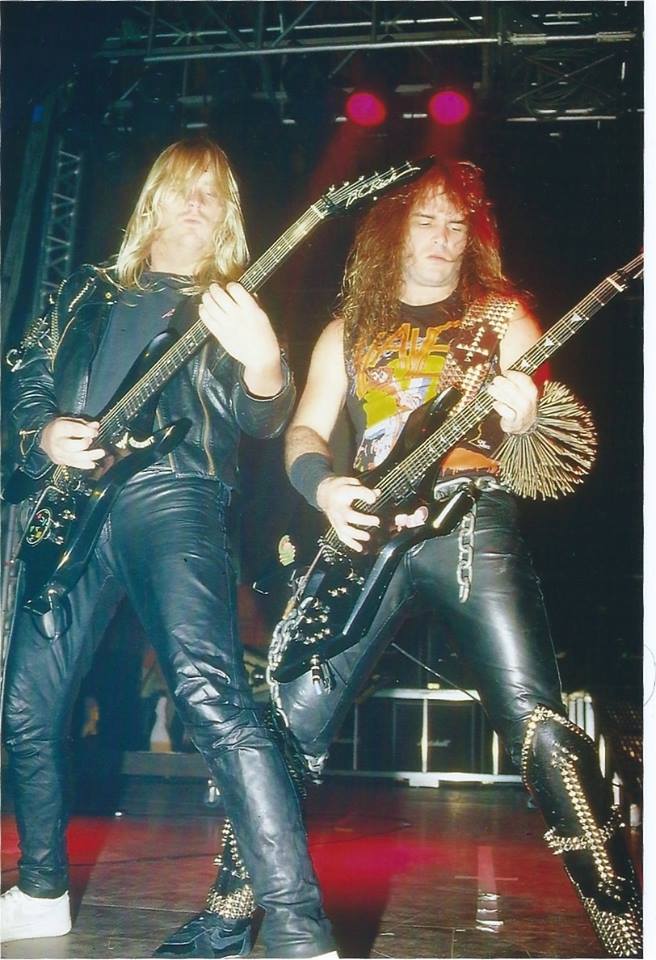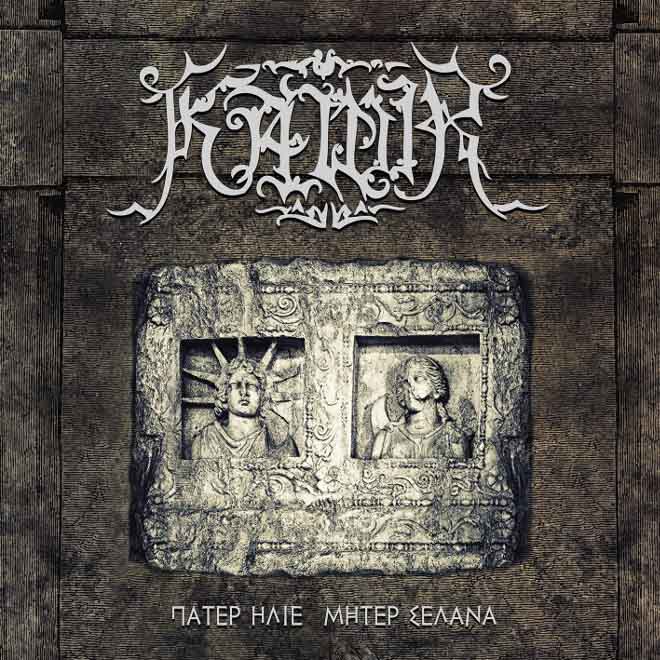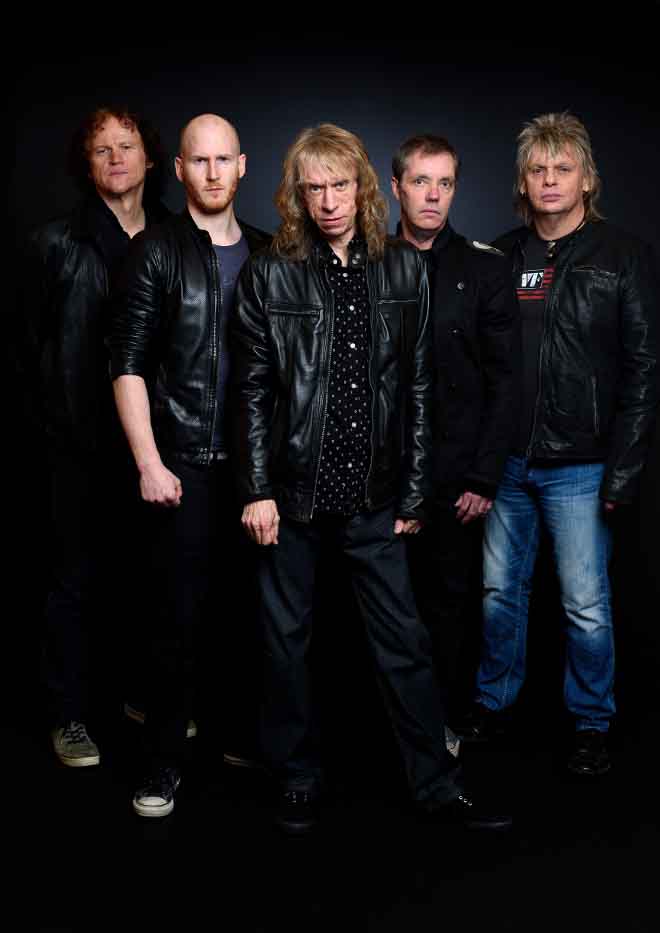Immortal, i.e. Demonaz and Horgh, have finished writing their new album. Now they just need to record it.
12 CommentsTags: abbath, Black Metal, Demonaz, drama, Heavy Metal, immortal, mainstream metal, news, upcoming release
Immortal, i.e. Demonaz and Horgh, have finished writing their new album. Now they just need to record it.
12 CommentsTags: abbath, Black Metal, Demonaz, drama, Heavy Metal, immortal, mainstream metal, news, upcoming release
Manowar are apparently planning a farewell tour.
6 CommentsTags: hard rock, Heavy Metal, manowar, news, power metal, tour, upcoming tours
Nick Menza, the former drummer of Megadeth, died onstage last night.
2 CommentsTags: deaths, Heavy Metal, megadeth, news, Nick Menza, Rust in Peace, Speed Metal
Sludgecore band Agoraphobic Nosebleed threw a fit for publicity over a recent batch of Death Metal Underground’s Sadistic Metal Reviews. Frontwoman Katherine Katz called us Fox News for our criticism of Agoraphobic Nosebleed’s shrieking short woman over a drum machine shtick and our psychological speculation as to why Agoraphobic Nosebleed would even bother releasing such failure other than for commercial exploitation of a musically-ignorant hipster fan base craving reaffirmation of their modern liberalism. Katz even claimed that artists should be responsible for the extreme actions of others in response to satire and that some topics should be completely off lyrics. For her, everyone who listens to “Embryonic Necropsy and Devourment” will potentially commit feticide. This is incredibly hypocritical for a band who shared a member with Anal Cunt and wrote Frozen Corpse Stuffed with Dope.
26 CommentsTags: Agoraphobic Nosebleed, Angel Witch, Black Metal, black sabbath, blessed are the sick, communists, death metal, Heavy Metal, His Majesty at the Swamp, masculinity, mercyful fate, metalgate, morbid angel, NWOBHM, Occultism, Philosophy, Root, Satanism, varathron, Zjevení
Article by David Rosales.
Released after Iron Maiden’s golden era, Somewhere in Time is touted by fans of heavy and power metal as a crown jewel of the band, exemplifying perfected expression and streamlined efficiency. This is not immediately convincing for metal hessians. Rightly so as the music became more sterile, hence, less credible. There is definitely a sense of “upgradedness” in both the production and the choice of stylistic voicings, allowing an inclusion of 80s pop coloration into the palette. This unclear, semi-sellout move demanded accountability, while at the same time the band boasted of accumulated experience fructifying the transformation, masterfully avoiding the typical degeneration that could be expected after the climax and summary of their original sound in 1985’s Live After Death.
34 CommentsTags: 1986, Heavy Metal, iron maiden, mainstream metal, NWOBHM, progressive metal, review, somewhere in time
Michael Denner and Hank Shermann (the dueling guitar virtuosos behind Mercyful Fate) have announced that the mixing and mastering is done on the upcoming album from their technical power/speed metal project, Denner / Shermann. Hopefully Masters of Evil (to be released by Metal Blade Records on June 24th ) is better than their previous EP but don’t get your hopes up. Check out the preview track below:
No CommentsTags: denner/shermann, Heavy Metal, mercyful fate, metal blade records, news, power metal, Speed Metal, technical, technical metal, wanking

Article by Lance Viggiano
Metal, like nearly every form of contemporary western music, carries legacy traits from western classical music. Noting these inherited qualities and their contribution to metal’s identity is a fruitful venture worth study. Yes, some artists such as Emperor created music that may as well have been performed by an orchestra. Nevertheless there is a distinct tendency among metalheads to validate metal through this heritage. The logic behind this is eloquent and simple: Classical maintains an esteemed position and metal retains compositional/artistic characteristics of classical; therefore metal is good (insert adjective for good: High Art, Quality, etc.). This does a disservice to metal however as it forsakes the baroque for the succinct while deriving much of its power from textural aesthetics. Metal needs to be qualified and judged according to its own merits.
Both forms of music arrange motifs according to an underlying narrative. The pathos of western classical music is derived out of experiments in harmony that attempted to imitate a well ordered and intricately planned cosmos. The composer embodies the role of the One God who conceives and executes a nature in which each of its parts cooperate in accordance with divine law or in the case of music: its score and story. Metal however is all about the riff; not just its position in the score but also the way it sounds and the way it feels. Downtuning a guitar, plugging it into a bass amp, and dialing the gain knob to its upper limit are not trivial or accidental decisions. The textural component gives the music body which allows for succinct motifs to achieve significance out of relative simplicity. On the other hand, classical must take on a ”notey” characteristic to give the music weight. The roar of an ensemble is a force of its own, yet it is comparatively tame next to the bludgeoning delivered by an amplifier and a few pedals.
Classical entices the mind with intricate and ornate patterns while metal ignites the heart by delivering an unabashedly barbaric, vitriolic and brash force of will. With each occupying distinct but equally valid dimensions of the human experience – The mind and the heart, respectively – it becomes clear that using one to validate the other does a great disservice to each form of music. Unplug metal and survey its patterns next to classical and one will find that it sounds as if it was composed by intellectually immature children. Plug classical patterns into metal and one finds that the need to make tonal sacrifices to retain clarity while distilling patterns down so as to be performed by fewer instruments results in sterile powerless wank which exists without proper support.
The Romantic movement turned its gaze back to the primacy of nature from the perspective of the civilized man who took all of his habits of thought with him; retaining his clear, distinct abstract patterns and hard mental boundaries. He walks at a distance from the forest so as to keep his boots from the blemishing mud and his coat from the shearing thicket. The Romanticism of metal walks barefooted against the cold soil, barely managing to escape the weather but never the bonds of nature. His damp stone refuge is aerated by a primate musk so thick that the festering gobbets and searing tendons of his kill cannot penetrate it. The civilized man understands nature as an idea from which he is blissful detached and divinely endowed to understand while the uncivilized man understands nature as an irrational outpouring of desire against which his only freedom is attained by projecting his own will against the world. Each vantage point offers a unique view of the same landscape. From that summit the artistry of metal ought to be discussed and ultimately, loved.
37 CommentsTags: article, beherit, black sabbath, Classical, classical music, composition, Dismember, emperor, Heavy Metal, metal, Philosophy, Romanticism, slayer

Article by David Rosales.
Kawir’s Father Sun Mother Moon strikes one as simple and mediocre pagan pop metal. From the recycled tunes to the standard, swinging rhythms of the genre that make actual metalheads cringe, Kawir has collected and presented them all to us on their new album. Kawir debases their music, pandering in the same way as those worthless politically-correct pop-dressed-as-metal bands like Turisas do. It really does sound like these Greeks could have been hanging out with Congressman Freddy Lim and Jesse ‘Djent-Black’ Liu of Cthonic, or drinking beers with the geeks from Tengger Cavalry. All these accusations are well deserved. The album therefore deserves to be dismissed as third-rate pap. Despite this, it is useful to look at this inconsequential list of boring tunes in terms of their de-evolution from Kawir’s previous album, Isotheos.
The concrete symptoms of banality and mediocrity can be found in the overall decline in richness of melodies and rhythms. Melodies have been shortened: they return much quicker to the root tone and rely more heavily on simple-silly rhythms ‘typical’ of Pagan pop. The variety of the types of melodies (that is the different arrangements of the motifs and their variations) are much less in number. Exactly the same with the rhythm guitars: less variety and where there was minimalism (which by definition, cannot be further simplified without loss of value), we now find a dumbing-down. The strict cyclic structures are far more evident in this album, replacing the quasi-linear Eastern European black metal which was used on their 2012 release. This uncreative disaster reaches unbelievable proportions when we encounter a dull track where after subjecting the audience to an ad nauseam repetition of a melody over a beer metal rhythm, Kawir simply fades out to avoid any shock to casual radio listeners in order to make it easier for the corporate broadcaster to place advertisements right after it.
While Isotheos melded melody and rhythm into a phrasal motific force, Father Sun Mother Moon clearly separates the paradigms of melody and rhythm. This in itself does not mean the end of the world but nothing is done to balance the combined simplicity. In fact, repetition plays an even greater role in filling out the runtime of this album: variations are less frequent, variation distance is smaller or unrelated, and single melodies or rhythms contain less content (movements from the tonic, manner in which they return to the tonic, temporary movements to different tonics, and even number of notes). Some sections on Father Sun Mother Moon reach the heights of the previous record but the overall quality is definitely lost.
2 CommentsTags: 2016, black 'n roll, Greek Black Metal, Heavy Metal, Iron Bonehead Productions, Kawir, melodic black metal, metal pop, modern metal, pop metal, review

A few weeks ago I conducted a short interview with Brian Tatler (center), the guitarist and primary songwriter of Diamond Head. Their new self-titled album was released on April 7th and will be reviewed on Death Metal Underground shortly. Marred by technical difficulties, here is an edited transcript:
Hi Brian, I’m Daniel from Death Metal Underground. I understand Diamond Head has a new album coming out this spring?
Yes we do. Diamond Head comes out April 7th.
Did you try to hearken back to your early work or go in a more commercial direction?
In a way. We took a look at everything we’ve done over the years. This album should sound like Diamond Head. We took a very Diamond Head approach.
Did you modernize your music? Use digital production and all that?
Well it’s still the old Diamond Head sound. I used a Diesel amp and we recorded into Pro-Tools too. We wouldn’t have been able to get that sound back in 1982. Writing is the main thing. We try to capture the magic in the rehearsal room.
Songwriting is the most important thing.
I agree.
So much modern metal is just one cool guitar riff and then chugging along until the next part that has no relation to the first.
You still need to write a song.
Who are your songwriting inspirations?
Well, Led Zepplin, Black Sabbath, those sorts of bands. I don’t listen to that modern sort of stuff that much. Some say we write the same songs over and over. That’s the way that stuff is. Diamond Head sounds like Diamond Head. The most influential records were the first few Led Zeppelin, Sad Wings of Destiny, Machine Head.
How do you feel about your influence on the metal and the more extreme sub-genres? Inspiring bands like Metallica, Celtic Frost, and Darkthrone who sometimes copied directly from you?
It’s easy to get deep into the stuff from your youth. You watch these bands play, get a tape from across the ocean a thousand miles a way, and after a few months of playing and writing your own material, what do you know? You have the same riff that’s on the tape! It’s nice to be influential. It makes the band feel important; justifies what we were doing. It’s been said Diamond Head were a musicians’ band: a band that other bands liked. We never sold that many records.
Even things like “Search and Destroy” having the same riff as “Sucking My Love” in a different key?
“Dead Reckoning”. It’s not the same; it’s slightly different. It’s flattering. I’ve got my own stuff from somewhere. Bits of Black Sabbath and AC/DC. Diamond Head were a stepping stone between thrash and them.
I noticed on songs like “The Prince”, you have tempo and rhythm changes in the drums uncommon for metal of the time.
Well we moved the drums around to get more out of each section. We had to get it as good as it had to be. No nudging through
“Am I Evil?” is perfect.
“Am I Evil?” took a while. It took a while to do it. The intro, lots of verses, the last section to the ending, and then going back to the main riff, and testing it out live.
So many bands never have the opportunity to play live now. How important was that?
We tested out everything live to see what songs and verses did work. What would work up a crowd. Some songs didn’t work. This one worked.
Did you start playing live early on?
We formed in ’76 and played our first show in February of ’77.
In local venues like pubs?
Lots of venues. Some not local. One in Birmingham. We started playing in pubs. No clubs. We would put on our own gigs.
Sabbath were from Birmingham. Was that a big deal?
We felt we were following in their footsteps: Black Sabbath and Judas Priest. It’s the second biggest city in the UK. Birmingham had so many bands. Always did too…
How much pressure did Diamond Head feel to become more mainstream and commercial rock?
A bit of pressure. We signed to MCA in 1982. Iron Maiden, Motorhead, and all UK bands appeared on Top of the Pops with their singles. Our long songs prevented that: “Sucking My Love” is 9 minutes long; “Am I Evil?” is 7:40 even. Not a comfortable fit. MCA wanted us to be more like Led Zeppelin except we had no PR, no real touring support with good lineups , nor a huge studio budget. Being managed by our singer Sean Harris’s mother didn’t help. We were dropped from MCA as she wouldn’t agree to a change in management.
Was it a Manowar type situation where he lived with his parents?
He lived with her then. I believe he still lives in the same place but on his own.
The Manowar singer still lives in his parents’ basement in upstate New York.
Ha
Any upcoming touring plans?
Lots of dates across Europe. We’re playing Hard Rock Hell and some dates in Germany, the UK, and Ireland.
Good luck!
Thank you!
Tags: Brian Tatler, diamond head, hard rock, Heavy Metal, interview, metallica, NWOBHM
Article by David Rosales
Kawir is a band that belongs to that side of metal whose discussion allows the true metal nihilist to distinguish between free minds who embrace the spirit of metal’s independence from political or religious doctrine. Metal has been characterized by its portrayals of power, courage and strength, while looking down on sheepish behavior, compliance with the system and general cowardice. When bands who openly express musical worship of Pagan ideals as a source for racial/national power, it gives one the opportunity to weed out the sheep in metal guise. The metal nihilist will find in the concept of the pagan theme in metal yet another expression of pride and power apt for the narrative of timeless natural struggle. He may dispassionately nod its head to the idea without necessarily embracing it as something that speaks to him, personally. He holds the burning flame of life in front of him, observing the destroying consumption that drives action in eternal co-dependence with passive materia. He stares at it directly without fear of having the miserable protective borders of human-society constructs burn away, nay, welcoming this removal of the illusory.
(more…)
Tags: 2012, Black Metal, Deathrune Records, flowing black metal, folk metal, Greek Black Metal, Heavy Metal, Isotheos, Kawir, melodic black metal, Mythology, review